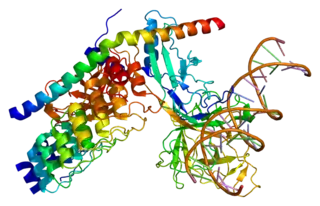RBPJ
La proteína recombinante de unión supresora de calvicie (RBPJ) es una proteína codificada en humanos por el gen RBPJ.[1][2][3]
| Proteína de unión a TATA | ||||
|---|---|---|---|---|
 Estructura tridimensional de la proteína RBPJ. | ||||
| Estructuras disponibles | ||||
| PDB |
Lista de códigos PDB 2f8x
| |||
| Identificadores | ||||
| Símbolos | RBPJ (HGNC: 5724) CBF1; IGKJRB; IGKJRB1; KBF2; MGC61669; RBP-J; RBPJK; RBPSUH; SUH; csl | |||
| Identificadores externos | ||||
| Locus | Cr. 4 p15.2 | |||
| Ortólogos | ||||
| Especies |
| |||
| Entrez |
| |||
| UniProt |
| |||
| RefSeq (ARNm) |
| |||
RBPJ,[4] también conocida como CBF1, es un homólogo del gen de Drosophila Su(H) (supresor de calvicie). Es clásicamente usado como una región promotora para demostrar la existencia de la ruta de señalización Notch.[5]
Interacciones
La proteína RBPJ ha demostrado ser capaz de interaccionar con:
Referencias
- Amakawa R, Jing W, Ozawa K, Matsunami N, Hamaguchi Y, Matsuda F, Kawaichi M, Honjo T (Oct de 1993). «Human Jk recombination signal binding protein gene (IGKJRB): comparison with its mouse homologue». Genomics 17 (2): 306-15. PMID 8406481. doi:10.1006/geno.1993.1326.
- Tang X, Saito-Ohara F, Song J, Koga C, Ugai H, Murakami H, Ikeuchi T, Yokoyama KK (Nov de 1997). «Assignment of the human gene for KBF2/RBP-Jk to chromosome 9p12-13 and 9q13 by fluorescence in situ hybridization». Jpn J Hum Genet 42 (2): 337-41. PMID 9290259.
- «Entrez Gene: RBPJ recombination signal binding protein for immunoglobulin kappa J region».
- «Human Genome Organization: RBPJ Report». Archivado desde el original el 12 de mayo de 2011.
- Hsieh JJ, Henkel T, Salmon P, Robey E, Peterson MG, Hayward SD (1996). «Truncated mammalian Notch1 activates CBF1/RBPJk-repressed genes by a mechanism resembling that of Epstein-Barr virus EBNA2.». Molecular and Cellular Biology 16 (3): 952-959. PMID 8622698.
- Kurooka, H; Honjo T (Jun. de 2000). «Functional interaction between the mouse notch1 intracellular region and histone acetyltransferases PCAF and GCN5». J. Biol. Chem. (UNITED STATES) 275 (22): 17211-20. ISSN 0021-9258. PMID 10747963. doi:10.1074/jbc.M000909200.
- Beatus, P; Lundkvist J; Oberg C; Pedersen K; Lendahl U (Jun. de 2001). «The origin of the ankyrin repeat region in Notch intracellular domains is critical for regulation of HES promoter activity». Mech. Dev. (Ireland) 104 (1-2): 3-20. ISSN 0925-4773. PMID 11404076.
- Zhou, S; Hayward S D (Sep. de 2001). «Nuclear localization of CBF1 is regulated by interactions with the SMRT corepressor complex». Mol. Cell. Biol. (United States) 21 (18): 6222-32. ISSN 0270-7306. PMID 11509665.
- Zhou, S; Fujimuro M, Hsieh J J, Chen L, Hayward S D (Feb. de 2000). «A role for SKIP in EBNA2 activation of CBF1-repressed promoters». J. Virol. (UNITED STATES) 74 (4): 1939-47. ISSN 0022-538X. PMID 10644367.
- Zhou, S; Fujimuro M, Hsieh J J, Chen L, Miyamoto A, Weinmaster G, Hayward S D (Apr. de 2000). «SKIP, a CBF1-associated protein, interacts with the ankyrin repeat domain of NotchIC To facilitate NotchIC function». Mol. Cell. Biol. (UNITED STATES) 20 (7): 2400-10. ISSN 0270-7306. PMID 10713164.
- Nam, Yunsun; Weng Andrew P, Aster Jon C, Blacklow Stephen C (Jun. de 2003). «Structural requirements for assembly of the CSL.intracellular Notch1.Mastermind-like 1 transcriptional activation complex». J. Biol. Chem. (United States) 278 (23): 21232-9. ISSN 0021-9258. PMID 12644465. doi:10.1074/jbc.M301567200.
- Aster, J C; Robertson E S, Hasserjian R P, Turner J R, Kieff E, Sklar J (Apr. de 1997). «Oncogenic forms of NOTCH1 lacking either the primary binding site for RBP-Jkappa or nuclear localization sequences retain the ability to associate with RBP-Jkappa and activate transcription». J. Biol. Chem. (UNITED STATES) 272 (17): 11336-43. ISSN 0021-9258. PMID 9111040.
- Hsieh, J J; Zhou S, Chen L, Young D B, Hayward S D (Jan. de 1999). «CIR, a corepressor linking the DNA binding factor CBF1 to the histone deacetylase complex». Proc. Natl. Acad. Sci. U.S.A. (UNITED STATES) 96 (1): 23-8. ISSN 0027-8424. PMID 9874765.
Enlaces externos
- MeSH: RBPJ+protein,+human (en inglés)
Este artículo ha sido escrito por Wikipedia. El texto está disponible bajo la licencia Creative Commons - Atribución - CompartirIgual. Pueden aplicarse cláusulas adicionales a los archivos multimedia.